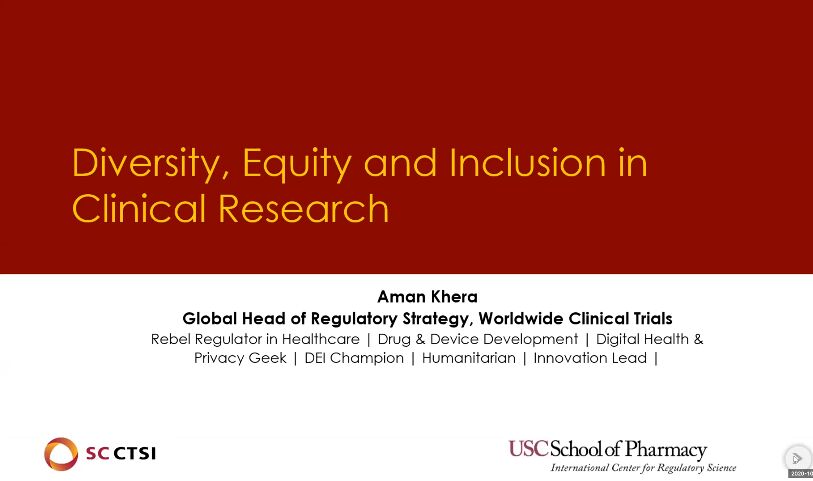1. Key Learning Objectives
a. Importance of Diversity, Equity and Inclusion (DEI) in clinical research (patients and beyond patients – sponsors too)
b. Obstacles of enrolling diverse populations
c. Understand implications of not enrolling patients from diverse populations.
2. Introduction
a. DEI affects: site level, sponsor level, patients
b. All of this brings out the diverse voice – getting voice heard (i.e. advocating for rare disease community)
3. The Importance of DEI
a. Diversity is rarely the focus of sponsor companies
b. Recent business imperative to have focus of DEI in CT
c. DEI has great value at site level
d. Industry is now under public scrutiny for not having diverse populations in CT
e. One country’s diverse population does not equal another’s
i. Obstacles remain the same though
f. Emphasis on collaboration (CRO’s, personnel at site, sponsor company together) to overcome obstacles
4. The Why
a. Disease and illness do not discriminate
b. Current struggle to look at basic level of diversity (i.e. gender)
5. What if nothing changes?
a. Variations in disease manifestation and treatment demonstrate why things do need to change
b. Failure to include diverse populations in CT, results in clinical research in a patient population which is not representative of the treatment’s intended patient population
6. Obstacles in reaching diverse populations
a. Sponsor and Site level
i. Need to focus on patient (put all patients first)
ii. Fear of delaying and/or increasing cost of trial
iii. Lack of trust from patient populations which are not represented in sponsor company staff
b. Investigator/Clinical Research staff perspective
i. Push for these personnel to question eligibility criteria – need diverse voices to work together to have most robust protocol to collect reliable data and include all populations
ii. People of color in clinical trial staff want to speak up, but hear from companies not to, are instead told they should have reached out earlier
iii. Some patient populations do not want to be included due to a lack of trust
iv. Need to explain terms cohesively, look into language requirements and make the language basic!
c. Should understand patient perspective to improve reaching out to patients
d. Large distrust currently in CT
e. Lack of awareness, which is why more health literature education is needed
f. Should we reconsider how (how much, how long it takes) to reimburse patients?
g. How do we keep patients involved?
h. Want to make CT process least burdensome for patients, so take good use of technological advances (while ensuring data privacy and increasing trust with patient)
i. No current harmonized requirements for data collection globally
i. Need to push agenda, call for harmonized data collection, gain more of a consensus in industry (between big and small pharma, virtual companies, sites etc.)
7. Engaging Communities
a. Need to be open to change and each individual should push for change
b. Advocacy groups are willing to help (so no need to solve problems alone)
c. Consider engaging with diverse patient communities BEFORE developing protocol
d. Translation/Interpreter services – how friendly is the information we are giving
e. Look at the protocols and give feedback on where the patient burden is (i.e. consider not having that tertiary endpoint)
8. The Diverse Voice
a. Are problems magnified due to a lack of diverse voice within biopharma and site companies?
b. Cultural competency programs may not be enough
c. Want to encompass diverse populations but also diverse voices working in the industry
9. Different Dimensions of Diversity
a. No be-all end-all recipe for success
b. A successful model for one diverse population does not necessarily equal the success model in another location’s diverse population
c. There are intersectional ties (there is no such thing as one box to place people in)
10. Questions
a. Any thoughts how to increase the collaboration of patients, physicians and sponsors, to reduce a burden on single party but benefit all?
b. Can you characterize the push-back from sponsors regarding diversity? It is about time and money: “we will think about it at a later date, when it is mandated”
c. Do you think there are enough forums for companies who have had push-back from regulators regarding diversity to share that? It is not really shared outwardly, no
d. Are there forums where industry shares their positive protocols for diversity? There has been positive collaboration between competitive companies, but it is not transparent for the public to see.
e. How do you typically deal with translations, are they made widely available? We follow what the sites are saying, more of a case where the sites prompt other stakeholders to provided translations, with no push-back from other players (sponsor, CRO’s).
f. There are also other diversity initiatives. But I wonder if these initiatives are too small. Are there larger countries or global initiatives to increase representation on a global scale?
Regulatory Science Symposium: Diversity in Clinical Trials in the Time of COVID-19 Session 5: Diversity, Equity and Inclusion in Clinical Research
Clinical Research
Diversity
Inclusion
Patient-Focused Care
Patient Voice
Patient Recruitment
Aman Khera
Global Head of Regulatory Strategy, Worldwide Clinical Trials
Course Syllabus/Topics
Acknowledgement
Accompanying text created by Annie Ly | Graduate Student, Regulatory Science, USC School of Pharmacy lyannie@usc.edu

